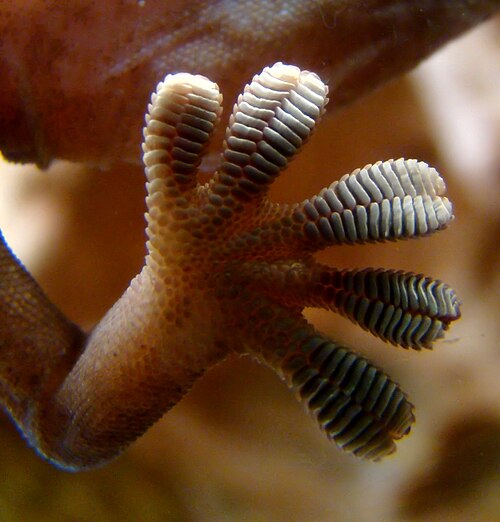Inbiology,setae (/ˈsiːtiː/;sg.seta/ˈsiːtə/; from Latin saeta 'bristle') are any of a number of different bristle- orhair-like structures on livingorganisms.

Depending partly on their form and function, protostome setae may be calledmacrotrichia,chaetae,scales, orinformally, hairs. The setal membrane is notcuticularized, so movement is possible.
Annelid setae are stiff bristles present on the body. They allowearthworms and their relatives to attach to the surface and prevent backsliding duringperistaltic motion. These hairs make it difficult to pull a worm straight from the ground. Setae inoligochaetes (the group including earthworms) are largely composed ofchitin.[1] They are classified according to the limb to which they are attached; for instance, notosetae are attached tonotopodia; neurosetae toneuropodia.[2] The setae onpolychaete worms are referred to as chaeta due to their differing morphology.
Crustaceans have mechano- andchemosensory setae.[3] Setae are especially present on the mouthparts of crustaceans[3] and can also be found on grooming limbs.[4] In some cases, setae are modified into scale like structures.[4] Setae on the legs ofkrill and other small crustaceans help them to gatherphytoplankton. It captures them and allows them to be eaten.
Setae on theintegument of insects are unicellular, meaning that each is formed from a single epidermal cell of a type called a trichogen, literally meaning "bristle generator". They are at first hollow and in most forms remain hollow after they have hardened. They grow through and project through a secondary or accessory cell of a type called a tormogen, which generates the special flexible membrane that connects the base of the seta to the surroundingintegument. Some insects, such asEriogaster lanestris larvae, use setae as a defense mechanism, as they can cause dermatitis when they come into contact with skin.[5]Diptera setae arebristles present throughout the body and function asmechanoreceptors.


The pads on agecko's feet are small hair-likeprocesses that play a role in the animal's ability to cling to vertical surfaces. The micrometer-scale setae branch into nanometer-scale projections calledspatulae.[6] ATokay gecko's two front feet can sustain 20.1 N of force parallel to the surface using approximately 14,400 setae per mm2. This equates to ~ 6.2 pN per seta, but does not sufficiently account for the overall stickiness behavior shown by the foot pads.[7]
In 2017, a description of a new species of basaldeuterostome calledSaccorhytus was published. This animal appears to have seta in the pores along the side of its body.[8] However, in 2022,Saccorhytus is considered to be an earlyecdysozoan, and was described as having "lacked setae".[9]

Inmycology, "setae" refer to dark-brown, thick-walled, thornlikecystidia found incorticioid andporoid fungi in thefamilyHymenochaetaceae.[10] Though mainly microscopic, the setae of some species may be sufficiently prominent to be visible with a hand lens.
Inbotany, "seta" refers to the stalk supporting thecapsule of amoss orliverwort (both closely related in a clade called "Setaphyta"), and supplying it with nutrients. The seta is part of thesporophyte and has a short foot embedded in thegametophyte on which it isparasitic. Setae are not present in all mosses, but in somespecies they may reach 15 to 20 centimeters in height.[11]
In the diatom familyChaetocerotaceae, "seta" refers to the hairlike outgrowths of the valve, i.e. of the face of the cells.[12] These setae have a different structure than the valve. Such setae may prevent rapid sinking and also protect the cells from grazing.
Synthetic setae are a class of syntheticadhesives that detach at will, sometimes called resettable adhesives, yet display substantial stickiness. The development of such synthetic materials is a matter of current research.[6][13][14]
Gecko "feet and toes are a hierarchical system of complex structures consisting of lamellae, setae, and spatulae. The distinguishing characteristics of the gecko adhesion system have been described [as] (1) anisotropic attachment, (2) high pulloff force to preload ratio, (3) low detachment force, (4) material independence, (5) self-cleaning, (6) anti-self sticking and (7) non-sticky default state. ... The gecko's adhesive structures are made from ß-keratin (modulus of elasticity [approx.] 2 GPa). Such a stiff material is not inherently sticky; however, because of the gecko adhesive's hierarchical nature and extremely small distal features (spatulae are [approx.] 200 nm in size), the gecko's foot is able to intimately conform to the surface and generate significant attraction using van der Waals forces.
{{cite book}}: CS1 maint: multiple names: editors list (link)